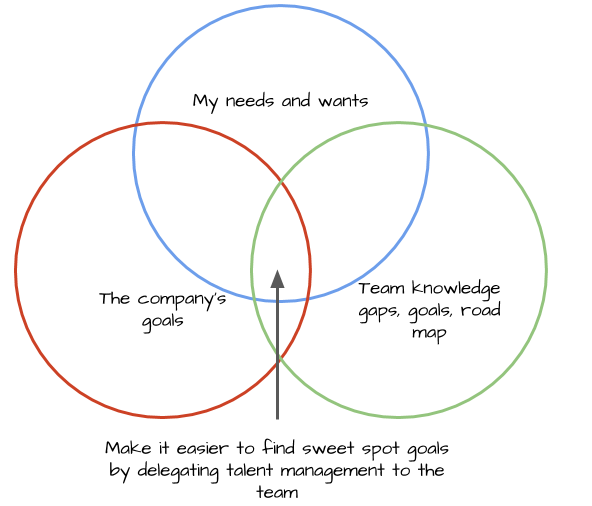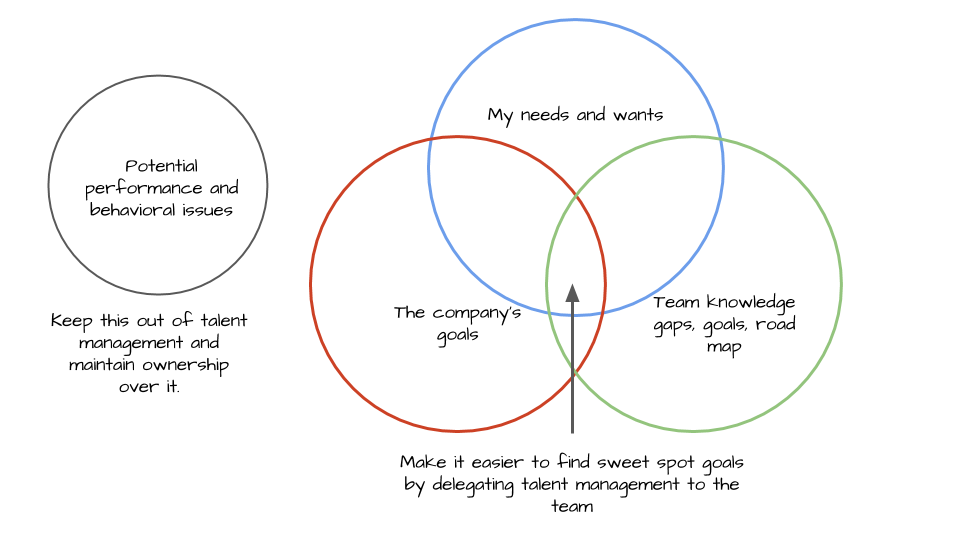Setting individual goals together increases performance, engagement, and motivation. This is because the team is better at creating a holistic overview of their current situation i.e. one that contains their collective knowledge gaps, personal interests, their goals, and company direction.
With that overview it becomes easier to find ways to contribute to the teams collective capabilities. I call the process of setting individual goals with the entire team “Team Talent Management”. Team Talent Managent makes individual goals more relevant. It also establishes a learning support network within the team that supports itself.
At the end of this post I offer an exercise that you can run with your team if you’d like to try Team Talent Management. Skip ahead if that’s what you came here for or keep reading to find out where talent management falls short today and what you can do about it.
Where Talent Management falls short today.
In many companies today, talent management is done out of context and individual goals are mostly based on what individuals want to learn. Managers may think that they’ve taken a holistic approach to talent management. After all, they’ve considering the individual’s needs and wants, have gathered feedback from team members, and have added their own perspective. as managers. But can that really be the case when development talks center almost entirely around the individual?

Don’t get me wrong: individual input is still the most important part of setting individual goals. You want people to have goals they’re motivated to work towards, after all. But when development conversations focus on individual growth without considering the teams context and the company long-term goals, you’ll miss growth areas that are more valuable to the team, the company, and, of course, the individual.
What’s the alternative? To involve the entire team in setting individual goals!
The missing dimension in the traditional approach is team’s context i.e. its challenges, growth areas, and goals (short and long term). Teams that seriously consider and let those aspects influence individual goals, outperform teams that define individual goals in isolation of context.

But is this approach really what’s best for the individual?
I’ve found that personal motivation goes up when people are able to have an impact with newly acquired skills. And since Team Talent Management leads to more relevant individual goals, you get a positive feedback loop leaving them desiring to learn more. As individuals become more competent in their craft, and more productive, happiness and job satisfaction also goes up.

Overcoming Obstacles
If you’re wondering how this fits in with traditional or current forms of management, you’re not alone. Team Talent Management is still a new concept, and, as with all new concepts and changes, conversations to discuss concerns and get buy-in need to take place.
To get started, you’ll want to focus on getting buy-in from the team and from managers. Here’s how you can approach these conversations:
Getting Buy-in From the Team
Regardless of whether you’re a team member, a manager, or a Product Owner (“PO”), you’ll need to get buy-in from other team members to set yourself up for success. Sometimes all that’s needed is just a simple conversation. Acknowledge any skepticism and fears, and clearly explain expectations and constraints. Follow up by highlighting the benefits that succeeding with this exercise would bring to the team. Help them really visualize the problems that this approach could solve.
Knowing If the Team Is Ready
Be mindful of group dynamics before trying this out. Teams that are newly formed or storming may not be ready to have growth conversations together. Low psychological safety can get in the way of the openness required to truly tap into the benefits of this approach.
If you’re a manager and want to try this but the team you have in mind is not ready, you can instead start by doing the groundwork that’s needed. Manage group dynamics now so that they’re ready to try this out the next time you set goals.
Getting Buy-in From Managers
There are three types of involvement the manager can choose:
- working closely with the team to help explore individual growth goals
- taking a step back to let the team explore on their own
- serving as a final checkpoint (and any combination in between).
To get buy-in from a manager, it’s important to have her consider how she wants to be involved. Involvement varies depending on the team’s, organizations, and her own needs and expectations.
The manager might not believe it’s a good use of her time or could be opposed to the idea in principle. That’s not how it’s been done throughout her long (and successful!) career, after all. Listen to her concerns with an open mind, but also paint her a picture of the benefits that this approach will bring for her and the team.
If the manager is on board but not sure about her level of involvement, help her evaluate where her interest and/or stake is with the model below. Explore whether she is more passionate about the growth/learning process or the learning outcomes.

There is one exception to the handover, however. As a manager, you’ll probably want to keep ownership of performance and behavioral issues rather than handing them over to the team. And that makes perfect sense. Such issues are best not to do on a bi-yearly or yearly cadence anyway.

Team Members That Are on the Wrong Team
“What about team members who are actively looking to change teams?” you might be wondering. In such cases, short-term learning goals may be relevant. Alternatively, another approach is to establish a personal development time budget. That way, people can dedicate some time to the needs of their current team and some for their future team. For example, 50% of the personal development time spent on skills that will help the current team. The other 50% could be invested in developing skills necessary for future teams. Or you might want to split that further to also include general career development. However, if a person is weeks away from leaving, you might want to have that person sit out the exercise entirely. Or she could contribute with context but not take on any learning goals of her own.
How It Works
Below I’ve outlined an exercise that you can run with your team, and preparations to have in place before you get started.
Preparations:
- A reasonably well-defined team mission and purpose. Have the PO prepare a few slides on this in advance to present at the beginning of the session. Show how team vision and goals fit together with the company’s vision and goals.
- Team goals stretching 3-6 months into the future. Try to raise them to outcomes and impacts rather than outputs. Roadmaps, User Story Map, or Impact Maps are good to bring with you. Note that goals should not come as a list of estimated outputs to deliver.
- Have each member reflect on their individual goals (as they relate to the team/things they feel comfortable sharing).
- Agreement between the team, the PO or PM, and the manager that wants to do Team Talent Management. Make it explicit whether this exercise is meant to be input for a future conversation between team members and the manager, or if you are aiming for deciding the learning goals in this exercise.
- Sufficient time. The exercise takes 1-2 hours depending on team size and goal cadence. With a small team, short goal cadence, and some practice, you can run this exercise in only 30-40 minutes.
- Constraints. Are there any learning budget constraints for example? And how much time is expected to be invested?
Running the exercise:
- Gather the team in a room.
- Revisit the team’s mission and goals. Have the PO to present the company vision, team mission, and team goals or metrics the teams need to impact.
- Highlight relevant team challenges. Ask people to share significant challenges they see on the horizon. Examples being “Lars who’s the only front end developer we have is going on parental leave in 3 months” or “Daily incidents are increasing” etc.
- Brainstorm individual and team development areas. Ask everyone to think about 3-5 things they could learn/skills they could develop to improve the team’s chances of reaching these goals. Also have everyone think about 1-2 things that the entire team could learn together that would improve the team’s ability to execute. (One thing per sticky). Help people clarify vague learning goals such as “Learn how to develop an app”, “Take a CCNP network certification”, or “Learn python”. Ask them what they hope to achieve by doing so and how that relates back to the team’s goals and needs.
- Evaluate the timeframe of the goal. Have people indicate if the learning goal is helpful short or long term. In other words, will this help the team solve an immediate problem or is this to prepare the team for future challenges? You’ll want a healthy mix over time!

- Prepare the matrix on the board. While everyone is busy writing, create a table/grid on the whiteboard with one cell per individual and the team. Make sure they are big enough to contain several post-its.

- Share findings. After 5 minutes, have people share their potential learning goals, how it would be helpful to the team, and what they think would be helpful if the entire team learned.
- Open up for clarifying questions, but postpone evaluation and judgement of goals.
- Also invite people to suggest learning goals for each other e.g. “I think it would be helpful to us if John learned scripting because we’re going to have a lot of automation next quarter.”

- Vote on which learning objectives would be most valuable to the team. Once everyone has shared their thoughts and added suggestions, it’s time for the team to indicate which goals they think will be most helpful. I suggest dot voting because it’s an easy way to indicate what the team thinks is most valuable. The individual can then choose to bring several stickies to discuss with her manager.

- Explore the most pressing objectives and the patterns behind them. Move the highest voted learning objectives onto the timeline. Look at the balance. A team with daily incidents might want to focus more on learning things that are valuable to the team next week. On the other hand, being aware of future challenges can create an urgency to learn things now that will help you avoid problems.

- Inform the manager (or team) what was decided. If your team and manager have agreed that the team can make growth decisions, inform the manager afterwards. If the final decision happens between the manager and team member, you need to follow up with the team once that’s done to let them know what was decided.
- Keep a physical reminder of what the team has chosen to focus on. At the end of this exercise, you’ll likely have a board that looks something like this. Put it up on somewhere close to the team or make it digital for dislocated teams.
Wrapping things up
Team Talent Management challenges traditional talent management thinking and many of the structures we have in place. But because there’s so much potential and the risk of trying is low with teams that are capable and interested in trying, it’s worth giving it a shot. It may take a few tries to get this right so don’t despair if , but you always have the old way to fall back on.
If you decide to try it out on your own, let me know how it went afterwards. I’d love to learn from your experiences.





2 Comments
ralph
Awesome! Thanks for sharing.
jimi friis
Tack! Very valuable content =)